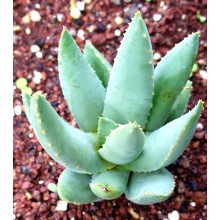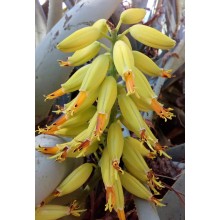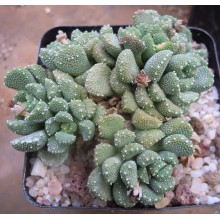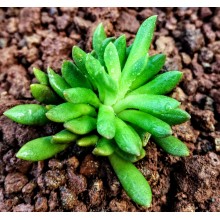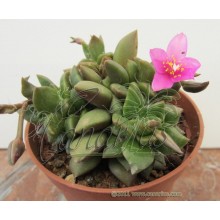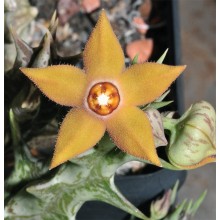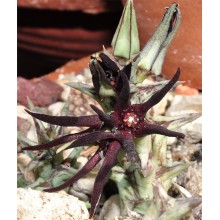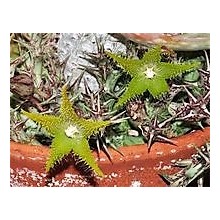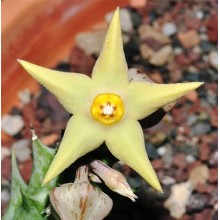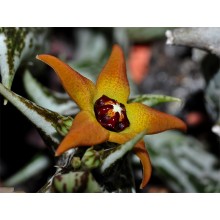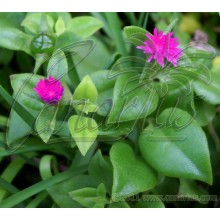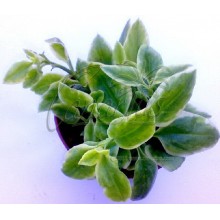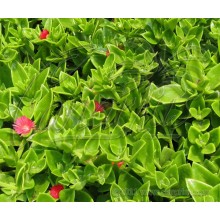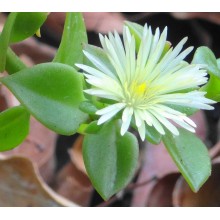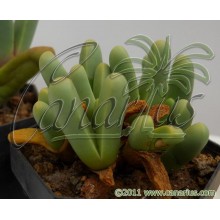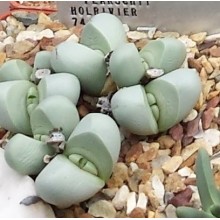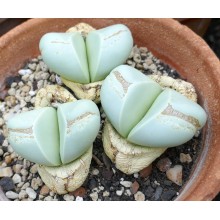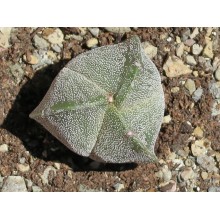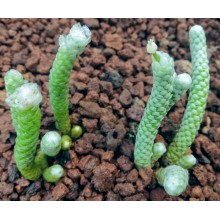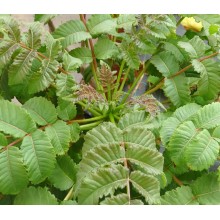Succulents There are 627 products.

World deserts and dry areas are home to the most interesting plants. Canarius offers an increasing selection of succulent plants of maximum quality, because they are grown outdoors, under the full sun of the Canary Islands.
Succulents or "fat plants" are water-retaining species, adapted to dry conditions. They store succum (juice, water) in their leaves, stems or roots, and often show a stout and fleshy appearance.
Subcategories
-
Agave
Agave is a genus of succulent plants from America. Some species grow in cold areas and take hard frost, while some others live in tropical climates. Some are tiny dwarfs and some are giants, up to 2 or 3 m wide.
Cold hardy agaves can create an exotic effect in your garden. Agave species make fine companions to palms or cacti. Variegated agaves are incredibly sought after by collectors. Our web shop offers an ever changing selection of species. We ship bare rooted plants, unless otherwise specified.
-
Aloe, Gasteria & Haworthia
Aloe, Gasteria and Haworthia are three related genera, comprising hundreds of succulent plants. They are all easily grown in pots. A few adapt to low-light levels of indoor conditions and can be grown as house plants.
- Aloe is a genus of about 400 species, native to Africa, Arabia and Madagascar. Small or dwarf aloes are becoming especially popular in colder climates as they can be taken indoors during the hardest months.
- Gasteria includes some 80 species endemic to South Africa, known for their spectacular leaves which are glossy, mottled and textured. They bloom in Spring-Summer with long spikes of small orange flowers. Some species are so variable that we offer particular clones from specific locations.
- Haworthia is a genus endemic to South Africa with about 70 species and a number of local subspecies, varieties and forms. Leaves are often banded, speckled, dotted, or semi-translucent and show wide variations.
-
Crassulaceae
This is a new, growing section of species from the family Crassulaceae. There are about 1,400 species in 33 genera and their distribution is worldwide, but mostly occur in the Northern Hemisphere and Southern Africa, especially in dry habitats. Here you can buy healthy, sun-hardened plants grown in the Canary Islands and shipped to your home.
-
Mesembs
This group of desert plants is briefly named Mesembs because they belong to a botanical family formerly named Mesembryanthemaceae. There are almost 2.000 species, mainly found in Southern Africa, with extreme adaptations to dry habitats. Some are called "living stones", as they look like pebbles. Many are easy to grow and their main need is full sun. Some are difficult because they grow in truly extreme areas.
Our Web Shop offers sun grown healthy plants, with compact and colourful leaves. Some plants are sold as cuttings, and others as rooted plants, of at least two years old.
-
Sansevieria
Recently assigned to the family Asparagaceae, the genus Sansevieria counts about 70 species, nearly all native to Africa, Arabia and Madagascar. Perennial herbs adapted to dry habitats with stiff, succulent leaves, their length ranges from a few centimeters to 2 meters. Sansevieria trifasciata and its many cultivars are among the most popular houseplants, popularly called mother in law's tongue. A well grown plant usually produces a spike of many white, richly scented flowers and then orange berries. Even the rarest species are resistant to neglect, provided you keep them from frost in winter and scorching sun in summer.
-
Hoya
Hoyas are twining vines, with showy exotic flowers, from the rainforests in Asia and Oceania. Most species grow in bright shade or morning sun, but they will also grow indoors as house plants. They are well suited for baskets, trellises or ladders. They tolerate a few weeks of drought but they are sensitive to frost and cold. Many hoyas are easy to grow and bloom, while some are tricky and rare.
-
Asclepiads
Asclepiads or Asclepiadoideae are a subfamily in the Apocynaceae, with about 2900 species. There are lots of leafless stem succulents but also perennial herbs, shrubs, lianas or rarely trees. They produce remarkable flowers, for the complex mechanisms they have developed for pollination. Many species produce an unusual fragrance, often called "carrion", and attracts flies for pollination. -
Caudiciforms
These plants from dry areas produce an unusually thick stem, the caudex. They are also called pachycauls and they have a disproportionately thick trunk, often with few branches. The caudex can be hidden underground, but in most cases they grow upwards, forming spectacular trees. The largest caudiciforms in the world are the baobabs. -
Other succulents
Here you will find all those species of desert plants that are not included in their own category. We will place here all plants from unusual families, other than Agaves, Aloes, Crassulaceae, Sansevieria, Mesembs, Epiphytic cacti, etc.
-
Aloidendron dichotomum 'Namibia'
Aloidendron dichotomum 'Namibia'
Aloidendron dichotomum is one of the most beautiful of the tree-aloes. has a very wide distribution of hundred of kilometers spanning from Namibia to RSA.
25,30 € -
Aloidendron dichotomum - RSA
Aloidendron dichotomum - RSA
One of the most exotic of all desert trees: this tree aloe stands out in dry areas of Namibia and South Africa. Throughout much of its range this species is in decline.
12,40 € -
Aloinopsis luckhoffii
Aloinopsis luckhoffii
Low growing clumping mesemb with beautiful warty leaves.
10,60 € -
Anacampseros marlothii
Anacampseros marlothii
Tuft forming Anacampseros from the Northern Cape province in South Africa.
10,30 € -
Anacampseros rufescens
Anacampseros rufescens
NEW! - Cont.= 8,5 cm. Low growing succulent from South Africa with succulent green pointed leaves that turn purple in bright light. Flowers are pink, reminiscent of Portulaca flowers.
10,60 € -
Angolluma 'aurantiaca'
Angolluma 'aurantiaca'
Branched plant. It's probably a new species related to Angolluma sprengeri.
20,80 € -
Angolluma dummeri
Angolluma dummeri
East-African Angolluma with creeping speckled stems, producing lime-yellow flowers with a white centre and lots of bright white "hairs".
18,30 € -
Aptenia cordifolia
Aptenia cordifolia
Four 14-20 cm cuttings - Creeping, fast growing groundcover mesemb with flowers in summer. This is the true A. cordifolia, with hearth-shaped leaves with bumpy surface and purple-pink flowers. It takes more cold than other aptenias.
11,00 € -
Aptenia cordifolia Variegata
Aptenia cordifolia Variegata
NEW ! - Branched plant. Delicate creeping succulent with cream and green foliage. Leaves are glossy, hearth-shaped and slightly succulent.
12,50 € -
Aptenia cordifolia x A. haeckeliana
Aptenia cordifolia x A. haeckeliana
Four 15-20 cm cuttings. Creeping, fast growing succulent plant with bright pink-red flowers in summer. This hybrid Aptenia is the perfect groundcover for gardens in coastal mediterranean climates. This is called Aptenia 'Red Apple' in the USA.
11,20 € -
Aptenia haeckeliana
Aptenia haeckeliana
Aptenias are excellent groundcover plants. They are creeping succulents, potentially evergrowing in the "mesemb" family: Aizoaceae. There are 4 species in the genus Aptenia and this A. haeckeliana is the beautiful one with the yellow flowers.
12,40 € -
Argyroderma fissum
Argyroderma fissum
Branched plant. Cont.= 8,5 cm. Pink flowered, clumping dwarf from the Knersvlakte desert in So.Africa. Leaves are blueish and finger-like. Rests in summer.
10,80 € -
Argyroderma testiculare
Argyroderma testiculare
Sphaeroid mesemb endemic to the quartz gravel of the Knersvlakte region, with jade-grey leaves. Location of this collection: Flaminkvlakte, population with 6 layered silky purple flowers
18,20 € -
Astrophytum myriostigma 'Tricostatum'
Astrophytum myriostigma 'Tricostatum'
This is an old classic selection of the popular Astrophytum myriostigma with only three ribs instead of the typical 5 ribs. Older specimens with only three ribs are highly prized because some add one more rib as they grow larger, so don't feed too much and grow it on the harsh side!
12,50 € -
Avonia papyracea
Avonia papyracea
White papery, papyraceous leaves grom from this marvel of nature from the Karoo desert in South Africa, where they grow in full sun among quartz rocks as their leaves reflect light.
9,80 € -
Beiselia mexicana
Beiselia mexicana
This small tree belongs to the Bursera family, the same of mhyrr, copal and frankincense. Beiselia belongs to its own plant genus, because it is quite different from its relatives. It is a very attractive and "weird" plant.
64,30 €
At the moment there are few products in this category Succulents

























